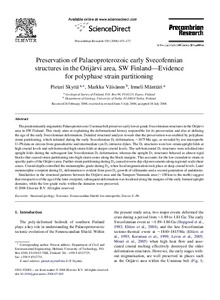Preservation of Palaeoproterozoic early Svecofennian structures in the Orijärvi area, SW Finland-Evidence for polyphase strain partitioning
Mänttäri I.; Väisänen M.; Skyttä P.
https://urn.fi/URN:NBN:fi-fe2021042715043
Tiivistelmä
The predominantly migmatitic Palaeoproterozoic Uusimaa belt preserves early lower-grade Svecofennian structures in the Orijärvi area in SW Finland. This study aims at explaining the deformational history responsible for its preservation and also at defining the age of the early Svecofennian deformation. Detailed structural analysis reveals that the preservation was enabled by polyphase strain partitioning, which initiated during the early Svecofennian D deformation, ∼1875 Ma ago, as revealed by ion microprobe U-Pb data on zircons from granodioritic and intermediate syn-D intrusive dykes. The D structures were low-strain upright folds at high crustal levels and sub-horizontal high-strain folds at deeper crustal levels. The sub-horizontal D structures were refolded into upright folds during the subsequent late Svecofennian D deformation, whereas the upright D structures behaved as almost rigid blocks that caused strain partitioning into high-strain zones along the block margins. This accounts for the low cumulative strain in specific parts of the Orijärvi area. Further strain partitioning during D caused reverse dip-slip movements along regional-scale shear zones. Crustal depth controlled the metamorphic grade during D , when local migmatisation took place at deep crustal levels. Later metamorphic overprint during D deformation is evident from post-D growth of sillimanite and a second generation of andalusite. Similarities in the structural patterns between the Orijärvi area and the Tampere-Vammala area (∼100 km to the north) suggest that irrespective of the age of the later overprint, subsequent deformation was localised along the margins of the early formed upright domains, while the low-grade rocks within the domains were preserved. © 2006 Elsevier B.V. All rights reserved.
Kokoelmat
- Rinnakkaistallenteet [19248]
